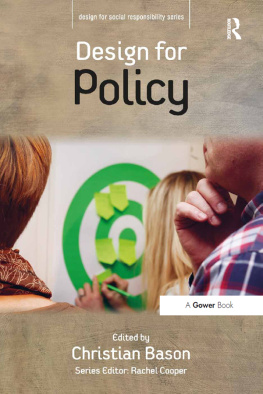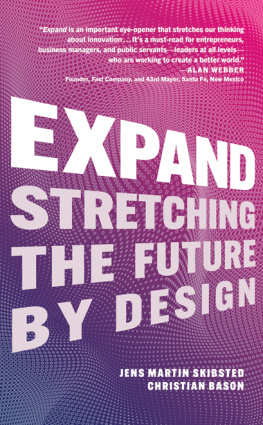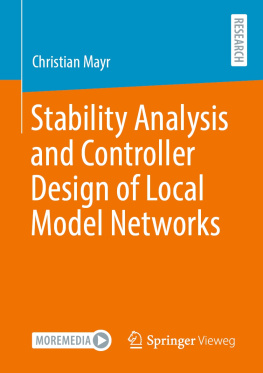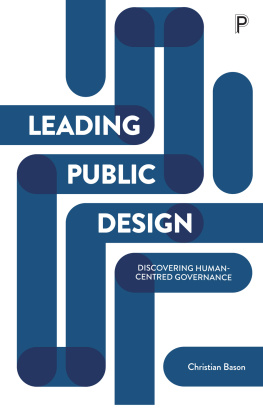Design for Policy
Design for Social Responsibility Series
Series Editor: Rachel Cooper
Social responsibility, in various disguises, has been a recurring theme in design for many years. Since the 1960s several more or less commercial approaches have evolved. In the 1970s designers were encouraged to abandon design for profit in favour of a more compassionate approach inspired by Papanek.
In the 1980s and 1990s profit and ethical issues were no longer considered mutually exclusive and more market-oriented concepts emerged, such as the green consumer and ethical investment. The purchase of socially responsible, ethical products and services has been stimulated by the dissemination of research into sustainability issues in consumer publications. Accessibility and inclusivity have also attracted a great deal of design interest and recently designers have turned to solving social and crime-related problems.
Organisations supporting and funding such projects have recently included the NHS (research into design for patient safety); the Home Office has (design against crime); Engineering and Physical Sciences Research Council (design decision-making for urban sustainability). Businesses are encouraged (and increasingly forced by legislation) to set their own socially responsible agendas that depend on design to be realised.
Design decisions all have environmental, social and ethical impacts, so there is a pressing need to provide guidelines for designers and design students within an overarching framework that takes a holistic approach to socially responsible design.
This edited series of guides is aimed at students of design, product development, architecture and marketing, and design and management professionals working in the sectors covered by each title. Each volume includes:
The background and history of the topic, its significance in social and commercial contexts and trends in the field.
Exemplar design case studies.
Guidelines for the designer and advice on tools, techniques and resources available.
Design for Policy
Edited by Christian Bason
First published 2014 by Gower Publishing
Published 2016 by Routledge
2 Park Square, Milton Park, Abingdon, Oxon OX14 4RN
711 Third Avenue, New York, NY 10017, USA
Routledge is an imprint of the Taylor & Francis Croup, an informa business
Copyright Christian Bason and the contributors 2014
Christian Bason has asserted his moral right under the Copyright, Designs and Patents Act, 1988, to be identified as the editor of this work.
All rights reserved. No part of this book may be reprinted or reproduced or utilised in any form or by any electronic, mechanical, or other means, now known or hereafter invented, including photocopying and recording, or in any information storage or retrieval system, without permission in writing from the publishers.
Notices:
Product or corporate names may be trademarks or registered trademarks, and are used only for identification and explanation without intent to infringe.
British Library Cataloguing in Publication Data
A catalogue record for this book is available from the British Library.
Library of Congress Cataloging-in-Publication Data
Bason, Christian.
Design for policy / by Christian Bason.
pages cm. (Design for social responsibility)
Includes bibliographical references and index.
ISBN 978-1-4724-1352-9 (hardback: alk. paper) 1. Policy sciences. 2. Design. I. Title.
H97.B377 2014
320.6dc23
2014021933
ISBN 9781472413529 (hbk)
For Lillian
CONTENTS
LIST OF FIGURES
LIST OF TABLES
RACHEL COOPER
PREFACE
I am thrilled to introduce Design for Policy as part of this series of books on design for social responsibility. Social responsibility is, or should be, core in policymaking. Indeed, our governments local, national and international form and create policies that are translated into regulatory and statutory frameworks that have a profound effect on our lives.
The use of design for and in policymaking has its roots explicitly in the development of service design, especially service design in social situations, but more implicitly design for policy has evolved from the notions of user-centred design, participatory design and co-design, in which everyone is engaged in planning products, services, experiences and social processes, and in the visual and textual expressions of these processes. However as with any design domain, Potter (1982) reminds us that everyone can be a designer, but some do it as a profession. While this is equally true for design and policymaking, this book reveals that an understanding of both domains is important for practice in this field.
This book is part of a series aimed at illustrating the value of design; for example, we have tackled the application of all the disciplines of design to aspects of contemporary life, such as transport and sport, services and sustainability, illustrating the multiplicity of ways in which design is applied to serve society. I am pleased to introduce this volume as the book that finally illustrates the policy context to which design can and is being applied. The examples here reveal the innovation brought about by the application of design to policymaking, whilst sharing the tools available to design for policy.
Christian Bason, whose practical experience of applying design during innovative policymaking is world leading, was generous in his agreement to edit the book and bring together global and diverse contributions to address the topic. In addition, he has eloquently summarized the state of the field and the reasons why design for policy is necessary in an increasingly complex and interdependent political, social, economic and environmental landscape. We now have a solid basis on which, as Bason suggests to position design on the policy stage. This book opens the stage curtain and narrates the first act, from which I hope much more research, practice and evaluation of design for policy can take place.
Reference
Potter, N. (1980). What is a designer, things, places, messages. Reading: Hyphen Press.
ACKNOWLEDGEMENTS
This book would not have been possible without the active encouragement of Rachel Cooper. Some years ago we both contributed to the European Commissions Design Leadership Board, an expert group established to generate ideas for strengthening design across Europe. Following one of our sessions, Rachel inquired if I might be interested in editing a volume, part of a series of design for sustainability, emphasizing the role of design for policy. I was immediately sympathetic to the idea, in particular since our work on the design board had confirmed something I had noticed in my national context in Denmark: whereas design for services is an increasingly acknowledged and well-defined discipline, design for policy is still an emerging and loosely defined field. To explore the notion of design policy would thus not only be a task of charting an existing landscape, it would have to be a contribution to defining it. What could be a more exciting challenge?
When some months later I asked the best people I could imagine if they would join me for the job, everyone accepted. This book obviously could not have been created without their efforts, dedication and, dare I say, patience throughout the writing and editing process. Many took up the suggestion, made by Joachim Halse, of collegial peer-to-peer feedback and made good use of that opportunity. I am indebted to everyone whose authorship is presented on these introductory pages for their generosity in sharing their research, insights and experience.













